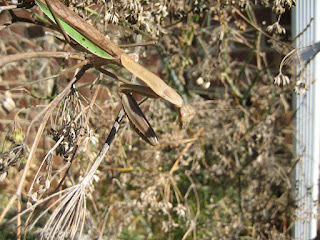 |
| Nest |
This leftover nest remains in one of the forsythias. The interior is smoothly plastered with a thin coating of dried mud. I haven't done any research yet but think it probably belonged to a robin or catbird.
I spotted it while wrestling honeysuckle out of the bushes.
Most of the trees have lost their leaves, but our little crape myrtle was still showing some fine color. Earlier in November I cleaned up and enlarged the flower bed around its toes to make room for planting bulbs: mixed tulips, grape hyacinths, and the forgotten daffodils I dug up accidentally. If you think you have spotted a great place for bulbs, you probably already planted some there! The back corner of this little bed is now home to a new, small clematis called Chevalier. It is still green, but has been outside just long enough to begin to show a slight touch of bronze.
Behind this bed, and to the right of the forsythia, is what's left of an old viburnum. Through the years it has suffered from our indecision about its ideal form (small, multistemmed tree or large bush?). In the meantime, the main central group of trunks died and rotted. Now all but the base of the dead center has been removed, leaving a sparse and scraggly cluster of younger shoots coming up from the roots. We hope that pruning will encourage them to branch out and act like a bush again. In the meantime, the leaves are a lovely golden shade. (See photos below. Someday I'll learn how to align them better.)
 |
| Crape myrtle "Natchez" |
 |
| Tulips, grape hyacinths, and daffodils |
 |
| Clematis "Chevalier" |
 |
| Viburnum |







